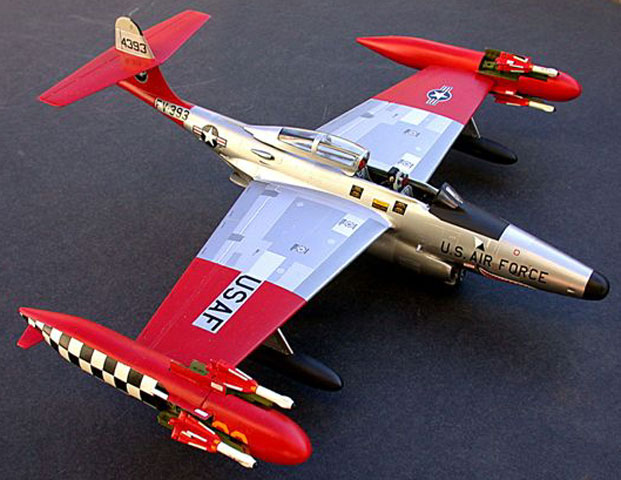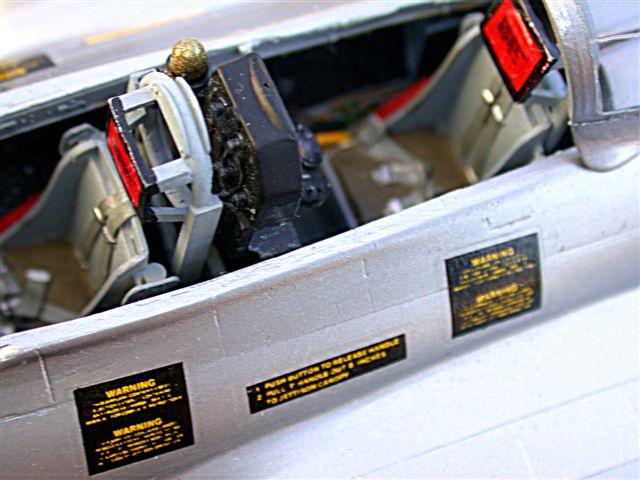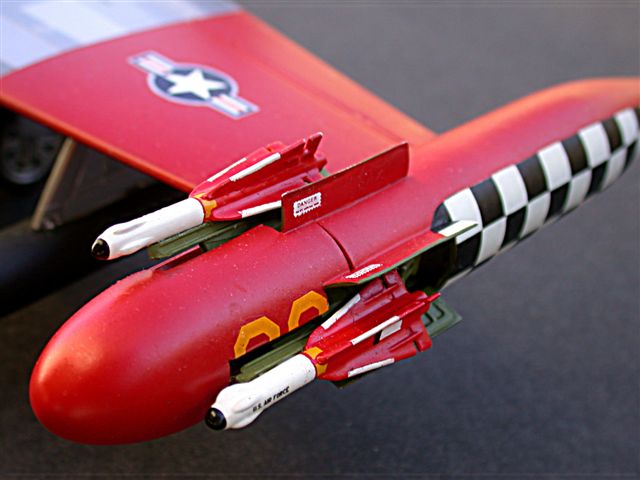|
Northrop F-89H Scorpion
by "Bondo" Phil Brandt
|

|
|
F-89H Scorpion |

HyperScale is proudly sponsored by Squadron
Bondo's 1966 navigator class
at Mather AFB, CA had among its fledgling Magellans two Iowa Air Guard
troops--one of 'em, Don Armington, eventually rose to head the Iowa Air
Guard--who were going back to Des Moines to fly (until 1969!) in the back
seat of one of the oldest aircraft in the USAF inventory, the Northrop
F-89J Scorpion. When we laughingly taunted them about their antique flying
machines, they'd come back with the comment that it was "the world's most
stable weapons platform" Having long ago stood on those gigantic wings at
the Florence, SC Air Museum, I guess so!
The F-89H, last new-build version of what was one of the earliest USAF
all-weather interceptors, featured huge wingtip pods that each contained
three AIM-4 Falcon missiles, twenty-one folded-fin, unguided rockets and
fuel! Begun in 1957, the H's Regular Air Force operational life was to be
a short one, and H models were heading for Air Guard service as early as
1958, having been supplanted by the J-model and the new F-102. The 75th
FIS in Presque Isle, Maine, one of the last active duty units to fly the
type, soldiered on with the H until mid-1959. The black-and-white
checker-boarded wingtip pods of the 75th are perhaps the most distinctive
of all Scorpion units.
I've always had a soft spot
in my modeling heart for the efforts of perhaps America's best known
Homeboy model producers, Revell and Monogram. For at least twenty-five
years, they set molding and complexity standards for kits of USAF
subjects, and even in today's "Golden Age of Modeling" many of their
subjects are still unopposed in the marketplace. The F-89D/J is one that
has stood the test of time, albeit with fine, raised panels.
Perhaps the ultimate
compliment to the 1991 kit is Black Box's release of an excellent resin
interior upgrade set.
I always liked the visual
complexity of the Falcon-equipped H models and started the scratchbuilding
conversion from the Revell kit years ago, well before Fox Three in Fort
Worth produced their resin H conversion set.
Airframe
The entire airframe was
sanded down with 400 grit and rescribed; a short sentence to describe a
much more drawn out procedure! Then, you'll need serious balancing weight
in the nose.
Cockpits

I had already finished
painting the stock Revell tub and seats when the BB interior set was
released, but since BB had taken pains to accurize all aspects of the
cockpit, especially the incorrect Revell portrayal of the left side of the
rear crew position, I started over, keeping only the Revell rear
instrument panel/radar scope which, although representing the D, was very
close to that of the H.
Weapons Pods
The H pods are somewhat
longer than the D and have a different nose contour. I formed the revised
nosecones from some scrap external tank noses and added A&B epoxy putty.
Lengthening plugs were cut from another F-89 kit. Door openings were cut
out and flooring added to each of three compartments per pod. Compartment
doors were scratchbuilt, with added door interior detail.

Note that the
small, forward doors fold inward; the larger aft ones open outward. My
many references (Aerofax, D&S, Squadron) show very few, if any, details
concerning the compartment interiors and the Falcon launchers, so I 'cannonballed'
Monogram F-106 launchers and AIM-4s. The pods were relocated slightly
forward on the wings due to the lengthening plugs.
Natural Metal Finish
After many iterations of
Blue Acryl, Mr. Surfacer, wetsanding (stepping up gradually from 400 to
8000 grit) and gray lacquer auto primer, Bondo's old standby, Alclad II,
did the NMF honors. Dural Aluminum, Dark Aluminum, Magnesium, Jet Exhaust
and a coupla customized shades gave a desired, 'busy' airframe surface,
whereas just one shade over all that wing area might have appeared boring.
Next, the future Insignia
Red areas were masked (luv that Tamiya yellow tape!) and first shot with
flat white undercoat to brighten the many red coats that followed. At this
point Bondo really 'stepped on it' because at every interface of red and
NMF was a slightly visible, hairline white layer...and although others
didn't think it was a big deal, the builder did! Sooo, it was remask time,
keeping the tape just a micron out from the existing white and red layers.
One more thin red coat covered the hairline white layer, and Bondo started
smiling again.

The weapon pods shared the same white undercoat as the airframe, and the
black and white checkers were created with good ol' Tamiya tape and the
Iwata. Note that by 1958 the H models of the 75th FIS had given up the
flashy overall pod/tail checker scheme of their D models (as seen in the
nice Revell 1/72 Scorpion kit) and had settled for a more maintainable,
checkered "slash" along the pod sides.
After masking and airbrushing the canopy frame, a U-shaped canopy-mounted
antenna was created from decal paper and sealed with a dip in Future. The
windscreen needed some fairly precise puttying to blend with the fuselage
base.
Rather than the initial orange-colored missiles, I invoked artistic
license and elected to do the AIM-4s in the later, red-and-white scheme as
carried by Deuces and Sixes. The red-and-white is much busier, especially
with proper decals (markings copied from pix in D&S Deuce book), and the
scheme coordinates nicely with the overall Scorpion colors nicely.
So sue me!
Decals
By 1958 the vertical fin was
by then overall red, minus the black and white checks, with a circular
squadron logo in black and white. The squadron logo was digitally copied
from the Squadron In Action book color centerfold, enlarged and jetprinted
on decal paper. Some black touchup paint was applied to the areas
surrounding the shark.

The shark's mouth on the bottom of the forward fuselage is from an old
aftermarket decal set (Repli-Scale SP002), and the stylized eyes (seen in
an Aerofax pic of a 75th H bird) were improvised from decal paper. The
actual shark's mouth on the H is slightly different from the decal (meant
for the 75th D) but at this point Bondo was tired and chose to invoke the
"Close Enough for Government Work" rule. At least it was from the same
squadron!
A long term (five years on
and off) project, to be sure, but Bondo never tires of the colorful USAF
jets that filled the skies in the Fifties and Sixties.
Click on the thumbnails
below to view larger images:
Model, Images and Text Copyright ©
2003 by Phil Brandt
Page Created 12 March, 2003
Last Updated
17 March, 2004
Back to
HyperScale Main Page |
Home |
What's New |
Features |
Gallery |
Reviews |
Reference |
Forum |
Search